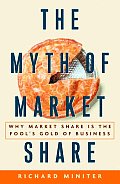 by Richard Miniter
by Richard Miniter
As countless dot-coms, their VCs, and three large car companies have discovered, buying customers is a lousy business plan.
Put that way, it seems intuitive, but not until Richard Miniter’s short but powerful little book, The Myth of Market Share, had I seen it put that way.
Most journalists, most bureaucrats, and too many businessmen operate under the delusion that market share is the royal road to profits. In fact, what matters to investors – and therefore, what should matter to management – is return on investment. Measured by return on capital, market leaders are often not profit leaders.
Why not? Doesn’t a large market share mean control of the market, and this, according to Porter’s Five Forces model, mean substantial pricing power? Isn’t pricing power the whole point of market share? Evidently not. Miniter is positing that nobody has pricing power, at least not outside normal economic cycles.
Then, the marginal customers whom you end up buying are rarely loyal, and have a lower profit margin, Having been bought by low prices, they are the kind that will desert you for them, as well, meaning that you can never raise prices on them in the presence of any competitors.
Moreover, by training consumers to buy only on price, they’re commoditizing products that can and should be sold on reputation. Cars and clothes are two of the more obvious products whose nameplates and labels should carry connotations of class and quality above and beyond the mere cost of their manufacture. If Chrysler wants to try to hang on to customers by tossing 100 years of brand equity out the window, they’re going to find themselves without either.
Even the companies that make progress through lower prices, notably Wal-Mart, do so not because of their non-existent pricing power, but because of their power as consumers. This is almost always the determinative force: even the trusts were losing their market share by the time they were broken up, and that the prices for their products (steel, oil, sugar, rail carriage) all continuously dropped during their existence.
So where did this idea come from? Miniter claims that it probably arose as a correlation between growth and profit after the Civil War during the time of the trusts. I’d place it on another phenomenon Miniter doesn’t mention: the company town and company store. True enough that abused their captive markets, but those conditions are hardly repeatable.
Then there’s the difficulty of defining your market. One of Porter’s Forces is the threat of substitutes, and companies frequently fail to take that into account. Smart CEOs can use this to their advantage. Jack Welch only wanted GE in markets where they could be number one or number two, but then made managers define those markets in such a way that they never had more than 10%. This suggests that market share can used as a metric, rather than a goal. This (as any honest advocate of affirmative action will tell you) is at the least a very tricky balance to maintain, but it may be worth considering in some cases.
Miniter basically eschews measuring yourself against your competition in favor of measuring yourself against yourself, and in doing so, echoes the recent advice in a number of business best-sellers. Organic growth is better than growth through purchase (Deals From Hell). Focus on customer service, and what you love and can do best (Good to Great).
It’s sound advice, and this book can help both managers and potential investors keep that in mind.